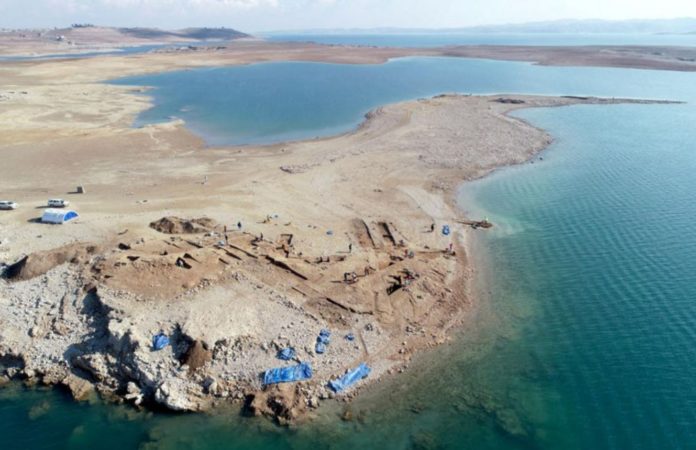Archaeologists from Germany and Kurdistan have discovered a 3400-year-old Mittani Empire-era city on the Tigris River. As a result of Iraq’s catastrophic drought, the village emerged from the Mosul reservoir’s waters at the beginning of this year.
The sprawling metropolis with a palace and other massive structures could be ancient Zakhiku, which is said to have been an important location in the Mittani Empire (ca. 1550-1350 BC).
Iraq is one of the world’s most climate-vulnerable nations. For months, the south of the country, in particular, has been suffering from severe drought. Since December, Iraq’s major water storage, the Mosul reservoir, has been drained to protect crops from drying up. This led to the resurfacing of a Bronze Age city that had been underwater for decades without any archeological research. It is located in the Kurdistan Region of Iraq, in Kemune.
This unexpected incident put archaeologists under immediate pressure to uncover and describe at least parts of this enormous, important metropolis before it was resubmerged.
Dr. Hasan Ahmed Qasim, chairman of the Kurdistan Archaeology Organization, and Jun.-Prof. Dr. Ivana Puljiz (University of Freiburg) and Prof. Dr. Peter Pfälzner (University of Tübingen) unexpectedly decided to conduct cooperative rescue excavations at Kemune.
In partnership with the Directorate of Antiquities and Heritage in Duhok (Kurdistan Region of Iraq), these took place in January and February 2022.
Within days, a team for the rescue excavations was assembled. The Fritz Thyssen Foundation, through the University of Freiburg, provided funding for the project on short notice. The German-Kurdish archeological team was under extreme time constraints because it was unclear when the reservoir’s water level would rise again.
The researchers were able to map the metropolis in a relatively short period of time. A gigantic fortification with walls and towers, a monumental, multi-story storage building, and an industrial complex were discovered in addition to a palace, which had already been documented during a brief campaign in 2018. The sprawling urban complex dates from the Mittani Empire (about 1550-1350 BC), which ruled over most of northern Mesopotamia and Syria.
“The huge magazine building is of particular importance because enormous quantities of goods must have been stored in it, probably brought from all over the region,” Ivana Puljiz explains. “The excavation results show that the site was an important center in the Mittani Empire,” Hasan Qasim says.
Despite the fact that the walls are composed of sun-dried mud bricks and have been underwater for more than 40 years, the research team was astounded by how well maintained they were — sometimes to a height of several meters. Because the city’s upper walls collapsed after an earthquake in approximately 1350 BC, the buildings were buried and preserved in their original condition.
The finding of five ceramic containers containing an archive of over 100 cuneiform tablets is very interesting. They date from the Middle Assyrian period, shortly after the city was devastated by an earthquake. Some clay tablets, which could be letters, are still sealed inside their clay envelopes. The researchers expect that this finding may reveal significant details concerning the end of Mittani rule and the beginning of Assyrian rule in the area.
“It is close to a miracle that cuneiform tablets made of unfired clay survived so many decades under water,” Peter Pfälzner adds.
As part of an intensive conservation project supported by the Gerda Henkel Foundation, the excavated buildings were totally covered with tight-fitting plastic sheeting and topped with gravel fill to prevent additional harm to the historic site from rising water.
During floods, this is done to protect the unbaked clay walls and any other treasures still buried in the ruins.
The site is once again underwater.
Image Credit: Getty
You were reading: Drought in Iraq Is Revealing Hidden Footprints of Historic Civilizations
